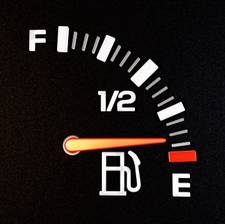
A gas gauge is a practical device that tells drivers roughly how much fuel is left in their vehicle's tank. Gas gauges have two components: what's known as a sender, which is mounted on the vehicle's fuel tank, and the actual gauge in the vehicle's instrument panel, which features a needle that pivots counterclockwise from F (for Full) to E (for Empty) as the supply of gasoline dwindles. Most late-model vehicles also are equipped with a low-fuel warning light. Many car owners know precisely how close to E---or far past---the gas gauge's needle can reach before they must fuel up. Others learn this lesson the hard way.
The sender measures the fuel level in a vehicle's tank. It typically consists of a foam float inside the tank that is attached to a thin rod. This rod extends outside the tank to a variable resistor that sends an electrical current to the gauge in the vehicle's instrument panel. When the tank is full, the float creates little pressure on the resistor and a strong current is sent to the gauge. The float sinks as the tank empties, creating more resistance so that a weaker current reaches the gauge.
Electrically charged heating coils have been used for decades to move the gas gauge needle that drivers see in their vehicle's instrument panel. Fed by a strong current from the sender when the tank is full, the coils would warm a metal strip. The heat then diminishes as current from the sender decreases, which permits the gauge's needle to move toward E.
Many new cars and trucks have microprocessors that measure the current coming from the sender, eliminating the need for heating coils. These gas gauges tend to be more accurate than their predecessors. Microprocessors also dampen the influence of hills and curves that caused the needles on older gauges to swing back and forth.